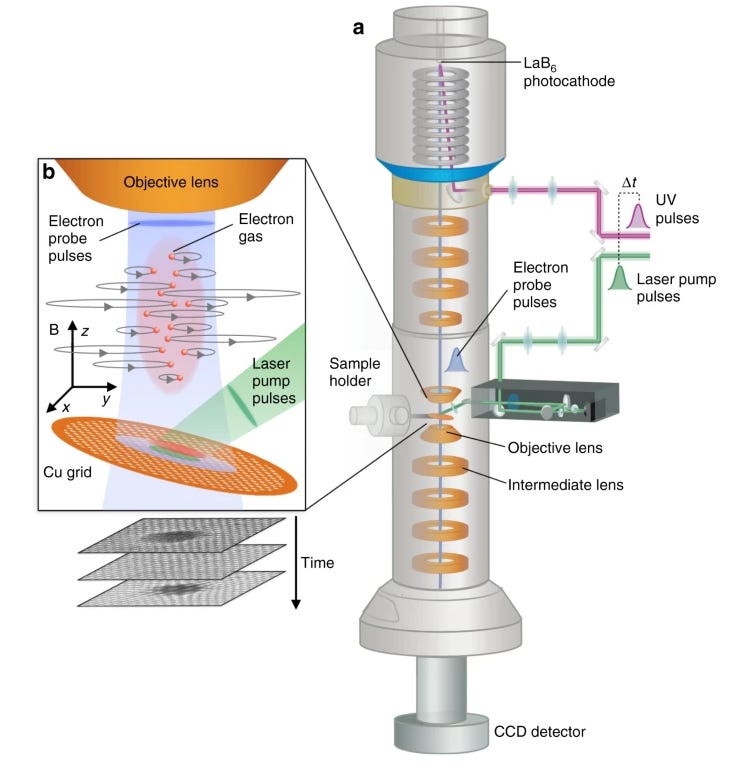Catch me if you can
At that point, we will have access to the very structure of reality and we will speak the native language of the universe.

Or the Ultrafast science
I have a colleague who, like me, reads science fiction and is fascinated by quantum physics. Yesterday he came into my office in a state of excitement and ordered me to open a news link, and I did it.
“At the University of Arizona, they have built the fastest and most complex electron microscope ever. A microscope that can even detect moving electrons,” I read aloud.
He looked at me and said, “You know that an electron travels more than 1.367 miles per second. Don’t you?”
“Sure,” I replied. “That’s more useful than my shoe size.”
He continues, not caring about my sarcasm, “But, can you believe it, Mic? They saw electrons moving. Amazing!”
He smiled at me, and I knew we’re going to talk about ultrafast science and stuff like that all day.
Ultrafast Science
Ultrafast science is concerned with processes and interactions at the atomic level. Electrons move on the “attosecond” time scale (an “attosecond” is a billionth of a billionth of a second); while molecular excitation occurs on the “femtosecond” time scale. Now, an electron microscope can make an object appear a million times larger. But the problem with observing particles like electrons is not that they are “small”, but that they are “fast”. This is why the “speed” of the microscope is so important. Think about the concept of “instant,” we cannot even visualize what we do in an instant. In fact, memory studies say that we usually forget what we experience if the speed is too fast. Well, Ultrafast science is at the heart of the University of Arizona researchers’ discovery.

The Attomicroscopy
A microscope that can capture moving atoms is a spectacular goal. When we think of a moving electron, our mind generally visualizes something like a sphere traveling in an elliptical orbit around the nucleus of an atom. But in QM, electrons do not move in elliptical orbits, but oscillate in a cloud of “probable” positions, that we call wave function, or Ψ. We move through space at “visible” and observable speeds, and we struggle to imagine such fast movements as to be invisible. The Arizona Team that built the atomic electron microscope needed to be able to “photograph” the ultrafast and invisible movements of electrons, and to do so they modified a traditional electron microscope relying on the principle “The faster the pulse, the sharper the image”. They called it Attomicroscopy.

Unseen Electron Dynamics
How they came up with this is not easy to explain, but if you want to dig deeper, you’ll find the original paper at the end of the article. Aside from the technical aspects, the most fascinating point is that imaging the dynamics of electrons in action also means that we may be able to understand space-time in a quantum system. So, the result of the Arizona ultrafast electron microscope brings us closer to a deeper understanding of the connection between time and space in a quantum system. Who knows, we may be able to overcome Heisenberg's Uncertainty Principle when “time” and its relationship to “matter” become observable at the quantum level. At that point, we will have access to the very structure of reality and we will speak the native language of the universe.
Fascinating, isn’t it?
Original Paper
Attosecond electron microscopy and diffraction original paper:
Abstract
Advances in attosecond spectroscopy have enabled tracing and controlling the electron motion dynamics in matter, although they have yielded insufficient information about the electron dynamic in the space domain. Hence, ultrafast electron and x-ray imaging tools have been developed to image the ultrafast dynamics of matter in real time and space. The cutting-edge temporal resolution of these imaging tools is on the order of a few tens to a hundred femtoseconds, limiting imaging to the atomic dynamics and leaving electron motion imaging out of reach. Here, we obtained the attosecond temporal resolution in the transmission electron microscope, which we coined “attomicroscopy.” We demonstrated this resolution by the attosecond diffraction measurements of the field-driven electron dynamics in graphene. This attosecond imaging tool would provide more insights into electron motion and directly connect it to the structural dynamics of matter in real-time and space domains, opening the door for long-anticipated real-life attosecond science applications in quantum physics, chemistry, and biology.
Authors:
Dandan Hui, Husain Alqattan, Mohamed Sennary, Nikolay V. Golubev, and Mohammed Th. Hassan
